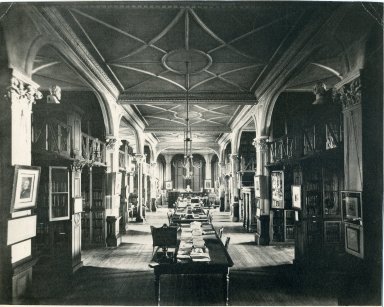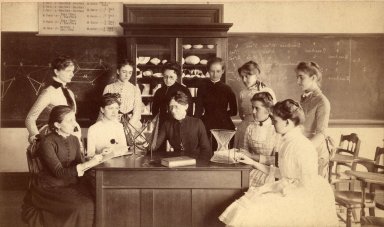As anyone writing historical or science fiction knows, it takes a lot of world-building when you’re first starting a new series. I’d like to introduce you to the world of my protagonist, Concordia Wells, an unmarried young lady making her way in 189os Hartford, Connecticut. The fictional elements are based upon a composite of events and trends in actual history.
On this page, you’ll learn about the college where Concordia lives and teaches.
Hartford Women’s College

Background:
1850-1874
As with many of the actual women’s colleges of the period (Mount Holyoke and Wellesley, for example), Hartford Women’s College was first created in 1850 as a ladies’ seminary. To learn more about the history of the ladies’ seminary movement, the metamorphosis of seminaries into colleges, and the controversy surrounding such a move, check out the Women’s Colleges page.
Several original buildings from the seminary days remain. Most notable in the story are Founder’s Hall, which now houses the library and faculty offices, and Memorial Chapel. Here’s a description of the chapel, from Dangerous and Unseemly:
Its Gothic-revival features gave the structure a sense of boundless height, from the pointed-arch windows and doors, to the vaulted ceilings and steep gables. The chapel proper was made of wood, with ornate scrollwork moldings throughout the interior. The asymmetrically-adjoining bell tower was constructed of local limestone, and topped with a crenellated parapet that made it look like a miniature castle. It had taken a few weeks of passing the building before Concordia could approach it without stopping to stare.

1875-1896 (present time of the novel)
In 1875, amid great debate and declining numbers at Hartford Ladies’ Seminary, the board of trustees decided to secure the necessary land and endowments to transform the institution into Hartford Women’s College. One of the most vociferous opponents of the conversion was a trustee, Arthur Richter, who ironically becomes the college’s second president, acting in that capacity during Concordia’s first year of teaching at the school. Concordia, having grown up in Hartford and knowing Richter from his association with her scholarly father, wondered at him taking on such a post, but then realized:
As president, Richter was in a unique position to control the direction of the college in its second decade. Under his leadership, the college had maintained some of the seminary customs designed to train young Christian women in decorous behavior and family life: daily Chapel, formal dinner dress, once-per-week (chaperoned) social visits, and strict enforcement of bedtime curfew, widely known as the “ten o-clock rule.” Male costume for student plays was not permitted, and the student basketball teams only recently were permitted to play in modified skirts and bloomers.
As it turns out, many disturbing things occur on campus which prove to be out of Richter’s control…but you’ll have to read about those in the book. 😉
The Faculty and Administration:

Hartford Women’s College has both male and female professors, although the women outnumber the men. The male administrators and some of the male professors live in Sycamore House, the residence of the college president. The men who teach at the college do not have to live on campus, although the president and dean are required to do so.
It’s a different story for the women faculty and administrators, and I based this upon how it actually worked at most women’s colleges of the time. Female administrators such as the Lady Principal (in charge of the faculty and second in position to the president), bursar, and librarian, along with some of the more senior women faculty, live in DeLacey House. All the other female professors are required to live in the cottages of their students (about two dozen in each cottage), although the teacher has a separate suite of rooms. The teachers act as live-in surrogate mothers. Helping the women faculty in this regard are resident matrons, sort of a cross between housekeeper and chaperone.
While we’re exploring that double-standard of responsibilities between the men and women faculty, let me point out that the women were not permitted to be married, while it made no difference for the men.
So, that’s a little preview of the college. I hope you’ll get a chance to check out Concordia’s Pinterest board, too! I’ve also started a group board on Pinterest: We Love Concordia. Would you like to join and pin some of your pics, too? Email me: contact (at) kbowenmysteries (dot) com


Hi Kathy,
Sounds like an interesting place for a book. I look forward to seeing what you come up with.
Kerry
Thank you, Kerry! Nice to see you here. 😀
I love the world you’re creating, Kathy. I’d love to take a trip there.
Me, too, Ellen, and thanks so much! 🙂
Very cool world and awesome page. This is a great idea! 🙂
Glad you like it, Rhonda – thanks! 😀
Very cool. I love all the old photos, and the information about the college is really cool. I love pages like this – and this one is very nicely done!
Thanks, Susan! I’m impressed by your research, too, and can’t wait until your book comes out!
Great idea 🙂
I very much like the notion and of course I love the pictures. It sounds interesting and intriguing.
Thank you, I.J.! I appreciate you stopping by. 🙂
Kathy – This is really interesting! It strikes me that women’s colleges of the time were a little like boarding schools. Perhaps the academic curricula were different but the living expectations strike me as somewhat similar. And those double standards…of course, I can’t say I’m surprised, given the era. I’m already really intrigued by this context, and I’ll be very interested to read more as you add it.
I’ll be adding characters next, Margot. Thanks for checking it out!
How interesting and fun!
Patricia Rickrode
w/a Jansen Schmidt
Aww, thanks Patricia! 😀
Great new page, Kathy! I love the teasers you inserted. I think this is great for your readers to get acquainted with the time period and the mores.
I’ve seen similar things done elsewhere and found it can be interesting…glad you liked it! Thanks, Marcia! 😉
Interesting. Nice to see that Concordia appreciates architecture. Maybe I’ll like her. Of course, to even know her could mean death — like riding a train with a quirky Belgian or living in Cabot Cove.
LOL, Bill – you have a point. Concordia seems to attract trouble. And who knew an oh-so-proper women’s college could be riddled with dark secrets? Thanks so much for visiting – I really appreciate it! 😀
This is VERY cool. And it’s giving me an appreciation for all the background exercises Kristen Lamb had me do. I’m guessing you, too. Eh? I can’t wait to read your book, Kathy. Holy Shizzlesticks. The anticipation is fantastic. You must be getting close.
Thank you, Renee! I actually had constructed this world long before I met Kristen. But I definitely learned a lot from the writing exercises we did in our WWBC group, too.
You’re right: I am getting very close to having a release date, and I’ll let y’all know as soon as it’s official. I so appreciate the fab support you’ve been giving me! 😀